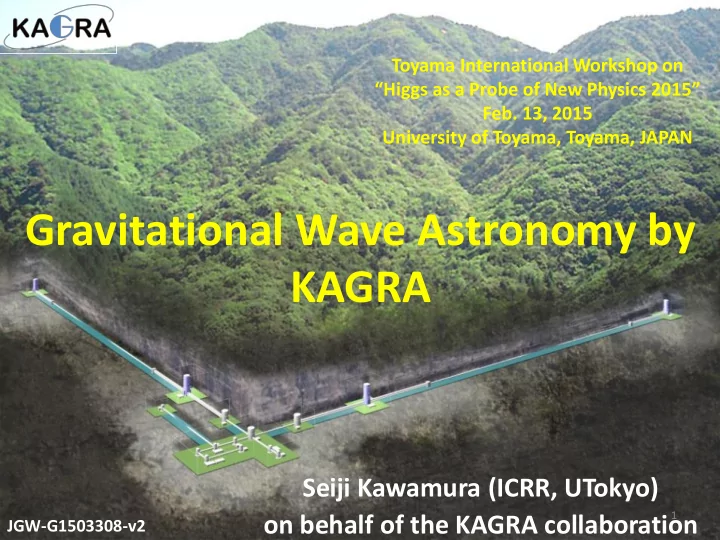

Toyama International Workshop on “Higgs as a Probe of New Physics 2015” Feb. 13, 2015 University of Toyama, Toyama, JAPAN Gravitational Wave Astronomy by KAGRA Seiji Kawamura (ICRR, UTokyo) 1 on behalf of the KAGRA collaboration JGW-G1503308-v2
Outline: Gravitational wave and its detection Review of KAGRA Current status of KAGRA Summary 2
Gravitational wave • Einstein Equation • For a small perturbation ‘ h ’ , a wave equation is derived
Gravitational wave • Predicted by A. Einstein • Not yet detected • Tidal space distortion of 10 -22 • Propagates at the speed of light
GW exists! PSR1913+16 found by Hulse se and Taylor Period of rotation decrease ses s by GW GW Nobel prize in 1993 Taylor et al., ApJ.345(1989) p435 5
Simulation of neutron star binary coalescence (1) 1.3 Ms – 1.6 Ms (Equation of state: APR4) Hotokezaka, et al. (Kyoto Univ, and others)
Simulation of neutron star binary coalescence (2) 1.2 Ms – 1.5 Ms (Equation of state: APR4) Hotokezaka, et al. (Kyoto Univ, and others)
Observation of the beginning of the Universe The beginning of the Universe Gravitation onal wave 10 -43 sec (Planck epock ) Neutrino Electromag agnet etic wave 1 sec 380,000 year (First atoms) 13.7B year (Recombination) (Now)
Gravitational wave detector Gravitational waves The mirrors and beam splitter are suspended. Mirror Mirror Lens Beam splitter Interfering light Screen Laser
Mirror Large-scale interferometer Mirror Mirror Laser Photodetector Mirror Laser Photodetector
Large-scale interferometers in the world GEO (600 m) TAMA (300 m) LIGO (4 km) KAGRA (3 km) CLIO (100 m) VIRGO (3 km) LIGO (4 km)
KAGRA 12
Location (Kamioka) Mozumi Entrance Super-Kamiokande CLIO Toyama airport Kamioka ◎ 40min. ◎ Tokyo by car Shin-atotsu Entrance 13
Key features Cryogenic Mirror of KAGRA Underground Technologies crucial for the 3rd-generation detectors; 14 KAGRA can be regarded as a 2.5-generation detector.
Two technologies + one Typical sensitivity of the 1st generation detectors Strain Frequency Undergro round nd Cryogenic c Mirror Resonan ant Sideband Extraction
Ground motion in Kamioka mine Kashiwa Kamioka 16
Further seismic isolation is still necessary Vibration of mirrors: 10 -11 mHz -1/2 Should be improved by 7 orders of magnitude 10 -18 mHz -1/2 @10 Hz
Vibration isolation system 2nd floor Inverted pendulum Geometrical antispring (GAS) filter GAS filter Multi-stage pendulum (with GAS filter) Two-layer structure to 1st floor avoid the resonances of Another pendulum the tall structure. (with GAS filter) Mirror suspension 18
Cryogenics System Platform (14 K) Upper Mass (15 K) 80K PTC with Mirror (20 K) Vibration reduction 2 units ~1W Cooling Main Beam Cryo-Payload 400kW 4W? 8K shield 2 units 300K 80K shield Duct Shield Radiation Cooling 8K shield Cryostat 19
Sapphire Mirror Two Sapphire substrates have been delivered. (Φ220mm, t 150mm, c -axis)
Resonant Sideband Extraction interferometer Fabry-Perot arm cavity: Increase the effective arm length -> Increase the GW signal Power recycling mirror: Increase the effective power -> Improve the shot noise Signal extraction mirror: Detuned for the best Extract GW signal before cancellation NS-NS inspiral range -> Optimize the quantum noise
Ultimate Sensitivity Limit of KAGRA Duty factor: > 80% Beating the standard quantum limit
Expected event rate for NS-NS coalescence Inspiral range: 176 Mpc (the same definition as LIGO/Virgo) Assuming Inspiral rate per galaxy: 100 Myr -1 Expected event rate: 10 yr -1 We could reveal the mechanism of Short GRB with -ray observation group. 23
Other GW sources • BH-BH coalescence: e.g. 20 M at 2 Gpc, 0.4 1000 events per year • Quasi-normal mode of BH: e.g. 100 300 M at 3 Gpc • Supernova: Hopefully 1 Mpc, 1 event per 30 years • Pulsar: Crab and Vela, possibly other invisible pulsars • Beginning of the Universe: non-standard model • Unknown: Nature likes to surprise us.
Schedule of KAGRA Calendar year 2010 2011 2012 2013 2014 2015 2016 2017 2018 Project start Tunnel excavation initial-KAGRA iKAGRA obs. baseline-KAGRA Adv. Optics system and tests Cryogenic system Observation iKAGRA bKAGRA Michelson interferometer Resonant sideband extraction Room temperature Cryogenic temperature 25 Simple seismic isolation system Advanced seismic isolation system
Shin-Atotsu entrance (2014.9.26) 片岡優氏撮影
1 st floor of central area ( 2014.7.4 ) 東京大学宇宙線研究所広報室
2 nd floor ( 2014.7.4 ) 東京大学宇宙線研究所広報室
Installation of beam tubes ( 2014.10.23 ) 片岡優氏撮影
Clean booth and sound-proof room ( 2014.10.31 ) 麻生洋一氏撮影
Summary • KAGRA has cryogenic and underground GW detector (2.5-generation). • We plan to build KAGRA in two steps: iKAGRA and bKAGRA. • We are installing iKAGRA now. • We plan to have an observation with iKAGRA at the end of 2015. • We plan to start observation run with bKAGRA at the end of 2017. 31
Recommend
More recommend